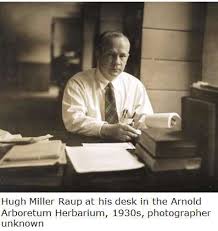In 1919 Hugh M. Raup and Lucy Catherine Gibson, both from farm families, graduated from Springfield High School and entered Wittenberg College. Hugh’s older brother, Robert Bruce Raup, had graduated from Wittenberg 10 years earlier, en route to a distinguished career as a philosopher at Columbia University’s Teachers College. At Wittenberg Hugh became a Philosophian, his future wife Lucy became a Euterpian. Hugh sang in the Glee Club; Lucy joined the YWCA.
Both joined the Biology Club.
 In the early 1920s, science at Wittenberg meant three professors: A. F. Linn, Professor of Chemistry and Mineralogy; E. O. Weaver, Professor of Physics; and Dean Charles G. Shatzer, George and Mary Greenawalt Professor of Geology and Biology. Shatzer’s broad background was crucial for Hugh Raup’s development: according to Raup’s colleagues seventy years later, it was Shatzer who “exposed Hugh to geomorphic processes, the cultural forces that shape nature, and a broad temporal perspective on landscape change.”
In the early 1920s, science at Wittenberg meant three professors: A. F. Linn, Professor of Chemistry and Mineralogy; E. O. Weaver, Professor of Physics; and Dean Charles G. Shatzer, George and Mary Greenawalt Professor of Geology and Biology. Shatzer’s broad background was crucial for Hugh Raup’s development: according to Raup’s colleagues seventy years later, it was Shatzer who “exposed Hugh to geomorphic processes, the cultural forces that shape nature, and a broad temporal perspective on landscape change.”
Wittenberg appointed Hugh to its faculty upon his graduation in 1923. While he pursued graduate studies at the University of Pittsburgh, he and Lucy began the summer field expeditions in northwest Canada that would make them famous. Lucy published a series of articles on lichens in The Bryologist in the 1920s/30s, and Hugh published Phytogeographic Studies in the Peace and Upper Liard River Regions, Canada in the 1934.
In 1932, the Raup family left Wittenberg for Harvard, where he joined the Arnold Arboretum, then the Department of Botany in 1938, and finally served as director of the Harvard Forest from 1948 to 1967. A few of Hugh’s articles give one an idea of his breadth:
- “Energy from Forests, “Proceedings of the American Academy of Arts and Sciences, Vol. 79, No. 4, Conference on the Sun in the Service of Man (Jul., 1951), pp. 212-220
- “Forests and Gardens along the Alaska Highway,” Geographical Review, Vol. 35, No. 1 (Jan., 1945), pp. 22-48
- “Botanical Problems in Boreal America,” Botanical Review, Vol. 7, No. 4, Botanical Problems in Boreal America. II (Apr., 1941), pp. 209-248
His most famous essay and lecture is “The View from John Sanderson's Farm: A Perspective for the Use of the Land,” Forest History, Vol. 10, No. 1 (Apr., 1966), pp. 2-11.
Hugh retired from Harvard in 1967, and Wittenberg awarded him an honorary Doctor of Science the next year. From his retirement home in Petersham, Massachusetts he maintained a lively correspondence with colleagues for decades, and with G. W. Argus he published The Lake Athabasca Sand Dunes of Northern Saskatchewan and Alberta, Canada, in 1982, at age 81.
Hugh and Lucy moved to Wisconsin late in life, where he died at age 94. Lucy died a few years later.
Hugh’s colleagues wrote of him:
Hugh's personal charm, his delightful habit of challenging new as well as established ideas, and his insights drawn from diverse ecosystems made him an exceptional mentor, colleague and friend. His work and ideas continue to challenge new scientists and provide a legacy to the institution that served as his home for nearly 40 years. With a tap and fuss at his pipe Hugh always mused carefully over one's remarks and reciprocated with thoughtful and provocative comments.
Sources:
Memorial Minute: Hugh M. Raup, Harvard University Gazette, February 12, 1998.
Some Biogeographers, Evolutionists and Ecologists: Chrono-Biographical Sketches
Trip Of A Lifetime: Three Alumni Recall Research Experience Near Arctic Circle
Wittenberg Magazine Article - Spring 2012 (story on page 15)
About The Project
With Wittenberg now celebrating its 175th year, and the University unable to hold regular in-person classes as a result of the COVID-19 pandemic, Professor of History Thomas T. Taylor has started circulating several pieces on Wittenberg's history. Some originated in earlier series, either This Month in Wittenberg History or Happy Birthday Wittenberg. Others have their origin in the Wittenberg History Project or in some other, miscellaneous project. Sincerest thanks to Professor Taylor for connecting alumni, faculty, staff, and students through a historic lens.

